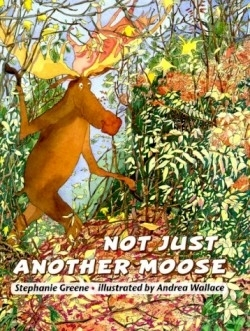Not Just Another Moose
From the first vision of Moose standing tall with his huge baked potato nose sniffing the air, readers can sense this is no ordinary character, especially with his five foot wide set of antlers sweeping up toward the sky, “like huge hands cupped to catch the rain.” But when the antlers fall off, what’s a moose to do?
Presented as a picture book with chapters, readers will gleefully follow the antics of Moose as he comes to terms with his own individuality, even without his ego defining antlers. Best friend Hildy, a wise plump pig, gets him over the first hump. She gives him a goofy blue cap with ear flaps to keep his new head warm. Hunting season then arrives at which time Moose must stay cooped up indoors reading books and drawing pictures. It turns out he’s quite an artist, as well as a superb donut maker. To pass the time he sets up an outdoor stand selling coffee, donuts and fine art to character number three, the gullible and agreeable hunter.
Even though the hunter suspects Moose of being a moose, he is too dazzled by Moose’s friendly witticisms to get much further than befuddled acquiescence. “When is a Moose not a Moose? When he’s an artist,” of course. The two meet twice more and by the end the hunter still wonders, “haven’t I seen you somewhere before?” While the hunter is a study of the comedic foil, Moose shines verbally and visually as a creative, effervescent creature. From bird watching to backpack wearing he carries the show.
The watercolor illustrations add the right touch of humor and detail to support the text. Spindly pen and ink lines create undulating forms. The dense, almost whimsical foliage surrounding Moose’s home (a cute clapboard cottage on the edge of a lake), often resembles the spiked freeform of Moose’s coveted rack. The layout of the page is super. At times a full page of art appears but always the art wraps around the text to create dynamic, concrete scenes. Plus, the superior use of white space is expansive and allows the art and text to work together as an integrated whole. Moose himself is a creature to behold. As in Laura Joffe Numeroff’s If You Give a Moose a Muffin (HarperCollins, 1991) illustrated by Felicia Bond, the personality of the moose is fully imbedded in body posturing and facial expression.
This is a book to share with elementary age children. With its focus on self acceptance, readers will clearly see, “There’s no such thing as good or bad…there are just different styles.”
Reviewed by
Martha Topol
Disclosure: This article is not an endorsement, but a review. The publisher of this book provided free copies of the book to have their book reviewed by a professional reviewer. No fee was paid by the publisher for this review. Foreword Reviews only recommends books that we love. Foreword Magazine, Inc. is disclosing this in accordance with the Federal Trade Commission’s 16 CFR, Part 255.

